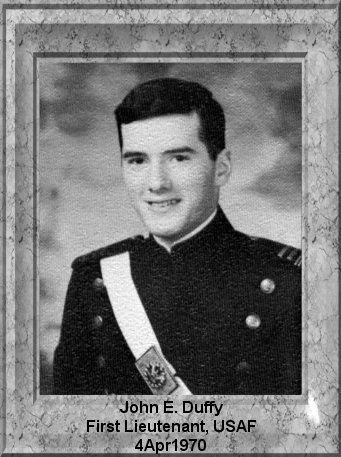In Memoriam
| John Everett Duffy On a warm spring afternoon, April 4, 1970, O2A pilot 1st Lt. Jack E. Duffy, took off on a visual reconnaissance flight from DaNang Air Base to Quang Ngai Air Base, Vietnam. He requested, and was granted, permission to fly visual reconnaissance in the area of Quang Ngai. Shortly after that he radioed his control party that he was at Ba To and was going to fly along the valley to Gia Vuc. With weather deteriorating in the area, tactical air control at Quang Ngai radioed Duffy instructing him to return to base. Duffy couldn't understand the transmission and asked them to repeat. Other reconnaissance pilots in the area tried to relay the message to him; they even flew the same route he reported taking in their efforts to contact him. They were unsuccessful. Extensive search efforts for Duffy continued, without success, until 11 a.m. on April 5. Jack Duffy was gone. On a rainy day more than 26 years later the serenity of Arlington National Cemetery was once again broken by the sharp report of rifle volleys followed by the haunting note of "Taps." Capt. Jack Duffy had come home to rest in honored glory. In the peaceful skies above, four F-16 fighter aircraft executed the missing man formation while the Air Force Honor Guard folded the American Flag of Duffy's casket. The U.S. and Prisoner of War-Missing in Action Flags rustled in a crisp breeze, beneath trees painted in fall foliage. Maj. Gen. William J. Begert, U.S. Transportation Command logistics and operations director, presented the flag, "On behalf of the U.S. Air Force and a grateful nation," to Duffy's brother, William. Members of the Captain's 1968 U.S. Air Force Academy graduating class were there for their classmate's long-awaited homecoming. Responsibility for bringing Capt. Duffy home belonged in part to Joint Task Force Full Accounting at Camp H.M. Smith, Hawaii. The task force, established in 1992, was created in response to presidential, congressional and public interest, as well as increased cooperation from the governments of Vietnam, Laos and Cambodia. JTF-FA has recovered the remains of more than 350 unaccounted-for Americans. Investigators and analysts have conducted more than 2100 case investigations and answered countless questions about many whose fate was previously unknown. A joint U.S. Vietnamese investigation team received a museum archival receipt for 1Lt. Duffy's ID card in May of 1991. Two witnesses provided information on a crash site relating to Duffy's case in 1992. In June 1993, an investigation team reached the site and found enough evidence to recommend it for excavation. In September 1994, a joint U.S.-Vietnamese team excavated the site recovering sufficient items to relate it to Duffy's aircraft. On Feb. 12, 1996, the Armed Forces Identification Review Board approved the identification of the remains as those of Jack E. Duffy. "The people in JTF-Full Accounting are absolutely committed to his mission," said U.S. Army Brig. Gen. James L. Campbell, JTF-FA commander. "I recently visited a team just as they were beginning their 30-day recovery mission conducted from a tent city in Boualapha, Laos. The recovery site was hot, humid, and wet." The teams faced the daunting task of digging hundreds of feet of trenches over a very large, muddy area thick with leeches and mosquitoes in search of two group burial sites. "Regardless of the difficulty of the case or the hardships encountered, the resolution of a case makes it all worthwhile," Campbell said. "The JTF-FA and the U.S. government are wholly resolved to see this mission through to completion. We will do whatever can be reasonably done to account for those who did not return." Click here to see the entry on the Virtual Wall Vietnam Veterans Memorial. |
